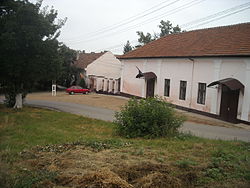Șiria, Arad
| Șiria | |
|---|---|
| Commune | |

Bohuș Mansion
|
|
| Coordinates: 46°15′53″N 21°39′49″E / 46.26472°N 21.66361°E | |
| Country |
|
| County | Arad County |
| Population (2002) | 8,140 |
| Time zone | EET (UTC+2) |
| • Summer (DST) | EEST (UTC+3) |
Șiria (German: Hellburg; Hungarian: Világos) is a commune in Arad County, Romania. According to the 2002 census it had 8,140 inhabitants.
The administrative territory of the commune is 12,106 hectares (29,910 acres) and it lies in the contact zone of the Arad Plateau and Zărandului Mountains. It is composed of three villages: Galșa (Galsa), Mâsca (Muszka) and Șiria (situated at 28 kilometres (17 mi) from Arad).
According to the last census, the population of the commune counts 8,140 inhabitants, of which 81.3% are Romanians, 4.4% Hungarians, 12.0% Roms, 1.8% Germans, 0.2% Ukrainians and 0.3% are of other or undeclared nationalities.
The first documentary record of Șiria dates back to 1169. Galșa was attested documentarily in 1202 or 1203, and Mîsca in 1331.
In 1785, it was destroyed by the troops of the Habsburg Empire.
In 1849, the village was part of the Kingdom of Hungary and it was a venue for the Revolutions of 1848 in the Habsburg areas, including the Surrender at Világos: on 13 August 1849 the Hungarian army led by Artúr Görgey surrendered to the Russian general Theodor von Rüdiger on the field below Șiria Castle, which brought an end to the Hungarian Revolution of 1848.
Although the economy of the commune is prevalent agricultural, the secondary and tertiary economic sectors have also developed recently. Șiria commune is known as an important viticultural centre of the region. Its resources include granite and limestone, mined in Galșa.
...
Wikipedia

